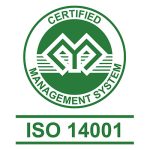ISO 14001 Environmental Management System
 Organizations of all kinds are increasingly interested in achieving and demonstrating substantial environmental performance that aligns with their environmental policy and objectives by controlling the effects of their activities, products, or services on the environment. This interest is driven by ever-tightening legislation, the development of economic policies, measures to strengthen environmental protection, and the growing concern of stakeholders about environmental issues and sustainable development.
Organizations of all kinds are increasingly interested in achieving and demonstrating substantial environmental performance that aligns with their environmental policy and objectives by controlling the effects of their activities, products, or services on the environment. This interest is driven by ever-tightening legislation, the development of economic policies, measures to strengthen environmental protection, and the growing concern of stakeholders about environmental issues and sustainable development.
The ISO 14001 International Standard is the most widely recognized environmental management standard worldwide. It defines the requirements for an effective environmental management system (EMS) that allows organizations to develop and implement policies and objectives, taking into account legal requirements and significant environmental aspects.
The standard is intended for organizations of all types and sizes and can be adapted to different geographical, cultural, and social conditions. The success of the system depends on the participation of personnel at all levels and functions of the organization, particularly the commitment of top management. An EMS enables an organization to establish an environmental policy, set environmental goals and objectives, and take appropriate actions to improve its environmental performance. The overall objective of ISO 14001 is to promote environmental protection and pollution prevention while meeting socio-economic needs.
ISO 14001 also forms the basis for other environmental certification schemes, such as the Community Eco-Management and Audit Scheme (EMAS). Additionally, it is designed to be compatible with other management system standards, such as ISO 9001, enabling organizations to integrate different management systems into a single, cohesive framework.
The benefits of implementing an Environmental Management System according to ISO 14001 include:
- Pollution prevention
- Reduction of environmental impacts
- Improved environmental performance
- Resource savings and cost reductions
- Ensured compliance with legislation
- Enhanced relations with regulatory bodies
- Application of environmental criteria to decisions, procedures, and materials management
- Implementation of environmental accident prevention programs
- Improved public image
- Increased staff awareness of environmental issues
